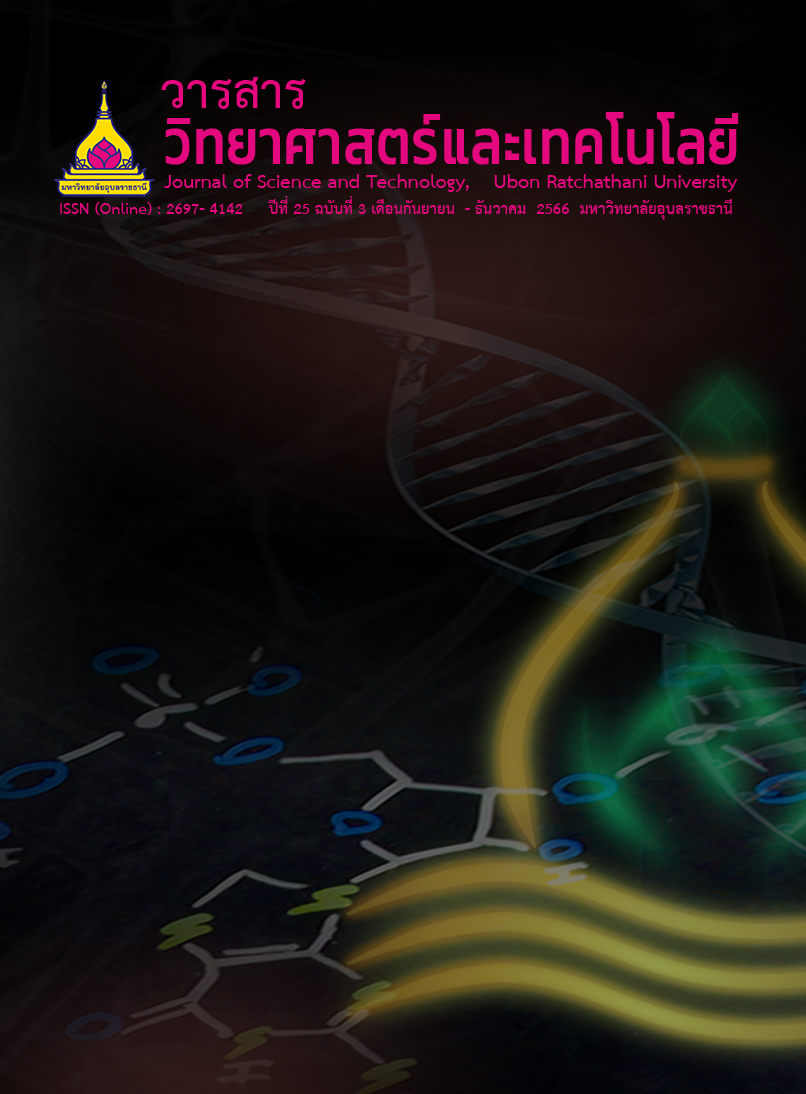ประสิทธิภาพในการกำจัดไวรัสของตู้ฆ่าเชื้อด้วยแสงอัลตราไวโอเลตที่พัฒนาโดยคณะวิศวกรรมศาสตร์ มหาวิทยาลัยอุบลราชธานี
Main Article Content
บทคัดย่อ
ในสถานการณ์โรคระบาด อุปกรณ์ทางการแพทย์มักมีราคาที่สูงขึ้นมาก ด้วยเหตุนี้ทางคณะวิศวกรรมศาสตร์ มหาวิทยาลัยอุบลราชธานีจึงได้สร้างตู้ฆ่าเชื้อด้วยแสงอัลตราไวโอเลต (ตู้ฆ่าเชื้อด้วยแสงยูวี) ขึ้น เพื่อให้มีอุปกรณ์ทางการแพทย์ที่มีราคาไม่สูงไว้ใช้ในสถานการณ์ดังกล่าว การศึกษานี้มีวัตถุประสงค์เพื่อทดสอบความสามารถของตู้ฆ่าเชื้อด้วยแสงยูวีที่พัฒนาขึ้นโดยคณะวิศวกรรมศาสตร์ มหาวิทยาลัยอุบลราชธานี ในการยับยั้งเชื้อไวรัส โดยการศึกษานี้ใช้ coliphage ซึ่งเป็นไวรัสที่สามารถบุกรุก Escherichia coli เป็นตัวแทนของไวรัส การศึกษาผลของเวลาที่ใช้ในการอบแสงยูวีต่อความสามารถของตู้ฆ่าเชื้อด้วยแสงยูวีในการยับยั้ง coilphage ทำโดยนำ coliphage ที่มีความเข้มข้น 105 pfu/mL ปริมาตร 10 ไมโครลิตรหยดลงบนจานอาหารเลี้ยงเชื้อ BHI agar แล้วนำไปบ่มในตู้ฆ่าเชื้อด้วยแสงยูวีเป็นเวลา 120, 60, 30, 20 และ 10 วินาที จากนั้นเททับ BHI agar ที่มีหยดของ coliphage อยู่ ด้วย soft BHI agar ที่มี E. coli ผสมอยู่ แล้วนำไปบ่มที่อุณหภูมิ 37 องศาเซลเซียส เป็นเวลา 24 ชั่วโมง พบว่าการอบแสงยูวีเป็นเวลาตั้งแต่ 30 วินาทีสามารถยับยั้ง coliphage ได้อย่างสมบูรณ์ การศึกษาผลของปริมาณไวรัสต่อความสามารถของตู้ฆ่าเชื้อด้วยแสงยูวีในการยับยั้ง coilphage ทำโดยนำ coliphage ที่มีความเข้มข้น 106, 107 และ 108 pfu/mL ปริมาตร 10 ไมโครลิตรหยดลงบนจานอาหารเลี้ยงเชื้อ BHI agar แล้วนำไปบ่มในตู้ฆ่าเชื้อด้วยแสงยูวีเป็นเวลา 30 วินาที จากนั้นเททับ BHI agar ที่มีหยดของ coliphage อยู่ ด้วย soft BHI agar ที่มี E. coli ผสมอยู่ แล้วนำไปบ่มที่อุณหภูมิ 37 องศาเซลเซียส เป็นเวลา 24 ชั่วโมง พบว่าการอบแสงยูวีเป็นเวลา 30 วินาที สามารถยับยั้ง coliphage ทุกความเข้มข้นที่ใช้ในการศึกษานี้ได้อย่างสมบูรณ์ จากการศึกษานี้ทำให้สามารถสรุปได้ว่าหากต้องนำตู้ฆ่าเชื้อด้วยแสงยูวีนี้ไปใช้งานจริงและต้องการให้ยับยั้งไวรัสได้อย่างสมบูรณ์ควรใช้เวลาในการอบแสงยูวีเป็นเวลาอย่างน้อย 30 วินาที
Article Details

อนุญาตภายใต้เงื่อนไข Creative Commons Attribution-NonCommercial-NoDerivatives 4.0 International License.
บทความที่ได้รับการตีพิมพ์เป็นลิขสิทธิ์ของ วารสารวิทยาศาสตร์และเทคโนโลยี มหาวิทยาลัยอุบลราชธานี
ข้อความที่ปรากฏในบทความแต่ละเรื่องในวารสารวิชาการเล่มนี้เป็นความคิดเห็นส่วนตัวของผู้เขียนแต่ละท่านไม่เกี่ยวข้องกับมหาวิทยาลัยอุบลราชธานี และคณาจารย์ท่านอื่นๆในมหาวิทยาลัยฯ แต่อย่างใด ความรับผิดชอบองค์ประกอบทั้งหมดของบทความแต่ละเรื่องเป็นของผู้เขียนแต่ละท่าน หากมีความผิดพลาดใดๆ ผู้เขียนแต่ละท่านจะรับผิดชอบบทความของตนเองแต่ผู้เดียว
เอกสารอ้างอิง
Dale Wilson, B., Moon, S. and Armstrong, F. 2012. Comprehensive review of ultraviolet radiation and the current status on sunscreens. The Journal of Clinical and Aesthetic Dermatology. 5(9): 18-23.
Amaro-Ortiz, A., Yan, B., and D'Orazio, J.A. 2014. Ultraviolet radiation, aging and the skin: Prevention of damage by topical cAMP manipulation. Molecules. 19(5): 6202-6219.
Chiappa, F. and et al. 2021. The efficacy of ultraviolet light-emitting technology against coronaviruses: A systematic review. Journal of Hospital Infection. 114: 63-78.
Douki, T., von Koschembahr, A. and Cadet, J. 2017. Insight in DNA repair of UV-induced pyrimidine dimers by chromatographic methods. Photochemistry and Photobiology. 93(1): 207-215.
Banas, A.K. and et al. 2020. All you need is light. photorepair of UV-induced pyrimidine dimers. Genes (Basel). 11(11): 1304.
Clark, E.M. and et al. 2012. Inactivation of recombinant bacteriophage lambda by use of chemical agents and UV radiation. Applied and Environmental Microbiology. 78(8): 3033-3036.
McDevitt, J.J., Rudnick, S.N. and Radonovich, L.J. 2012. Aerosol susceptibility of influenza virus to UV-C light. Applied and Environmental Microbiology. 78(6): 1666-1669.
Lamont, Y. and et al. 2007. Pulsed UV-light inactivation of poliovirus and adenovirus. Letters in Applied Microbiology. 45(5): 564-567.
Eickmann, M. and et al. 2018. Inactivation of Ebola virus and Middle East respiratory syndrome coronavirus in platelet concentrates and plasma by ultraviolet C light and methylene blue plus visible light, respectively. Transfusion. 58(9): 2202-2207.
Biasin, M. and et al. 2021. UV-C irradiation is highly effective in inactivating SARS-CoV-2 replication. Scientific Reports. 11: 6260.
Alvi, I.A. and et al. 2018. Storage of bacteriophages at 4oC leads to no loss in their titer after one year. Pakistan Journal of Zoology. 50(6): 2395-2398.
Golec, P. and et al. 2011. A reliable method for storage of tailed phages. Journal of Microbiological Methods. 84(3): 486-489.
Dai, T. and et al. 2012. Ultraviolet C irradiation: an alternative antimicrobial approach to localized infections? Expert Review of Anti-Infective Therapy. 10(2): 185-195.
Pereira, R.V. and et al. 2014. Evaluation of the effects of ultraviolet light on bacterial contaminants inoculated into whole milk and colostrum, and on colostrum immunoglobulin G. Journal of Dairy Science. 97(5): 2866-2875.
Prussin, A.J., Garcia, E.B. and Marr, L.C. 2015. Total virus and bacteria concentrations in indoor and outdoor air. Environmental Science & Technology Letters. 2(4): 84-88.
Phumkhachorn, P. and Rattanachaikunsopon, P. 2019. Bacteriophages: Biology and applications. Journal of Science and Technology, Ubon Ratchathani University. 21(3): 1-13. (in Thai)


